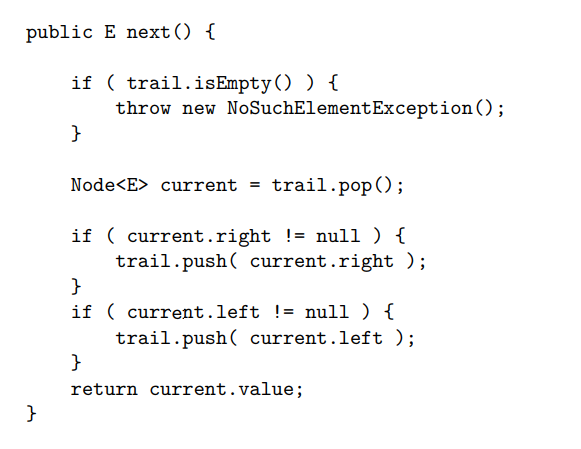Binary Tree
1/44
There's no tags or description
Looks like no tags are added yet.
Name | Mastery | Learn | Test | Matching | Spaced |
|---|
No study sessions yet.
45 Terms
binary tree
a tree-like hierarchical data structure such that each NODE stores a value (instance var value) and has at most two children: left and right (instance node vars)
the left node stores a value less than the value of the node
the right node stores a value greater than the value of the node
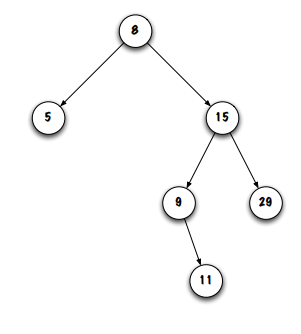
all nodes except ONE have exactly ______
one parent
a node that has no parent is called the _____
root
drawn at the top of the diagram
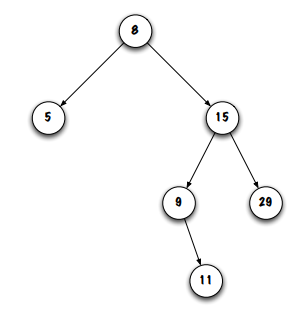
each node has ________ children
0, 1, or 2 children
nodes with no children are called _______
leaves (or external nodes)
in the image, 29 and 11 would be considered leaves
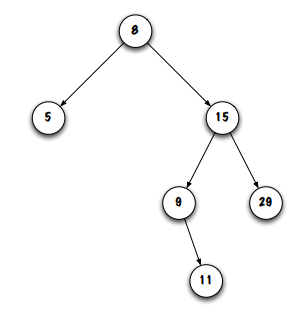
links between nodes are called ________
branches
a node and its descendents is called a ______
subtree
size of a binary tree
how many nodes are in the binary tree
an EMPTY tree (no nodes) has size 0
binary trees can be defined ________
recursively
depth of a node
the number of links starting from the root that must be followed to reach that node.
the root is the most accessible node. → the depth of a root is always 0
the depth of “15” in the image is 1
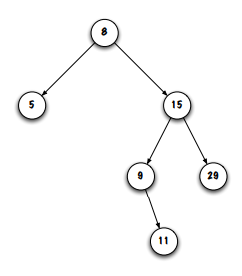
depth of a tree
depth of the deepest node
here, the depth of the tree would be 3 (the level where “11” is"
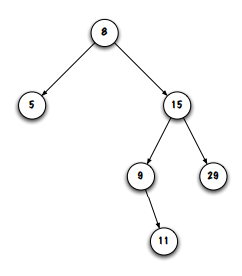
binary seach tree
a binary search tree is a binary tree data structure such that:
the nodes of a LEFT sub-tree only have elements that are less than the element stored at the local root of the subtree (or is empty)
the nodes of a RIGHT subtree only have elems that are GREATER than the elem stored at the local root (or is empty)
this means that a binary search tree has NO duplicates and is always ORDERED
binary search tree instance vars and nested node class
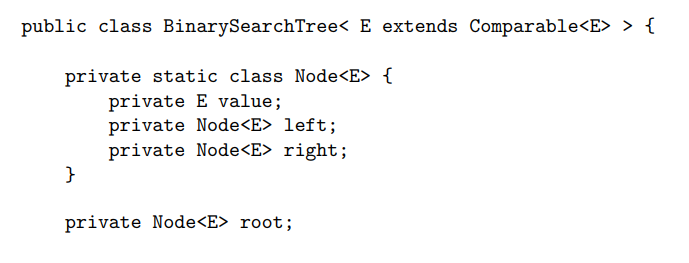
binary search tree memory diagram of a node
note that this is a memory diagram of the root node with no children
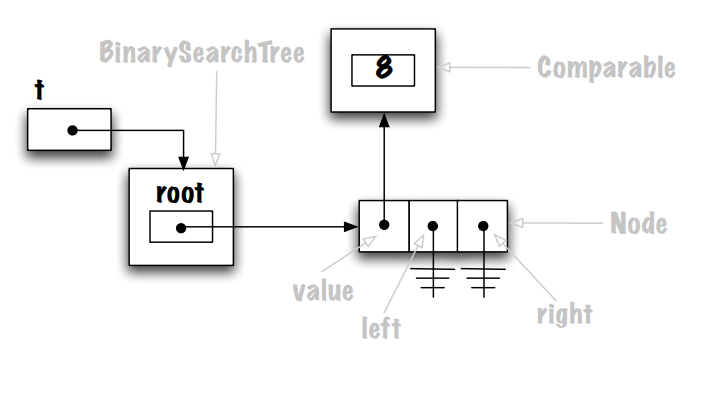
binary search tree memory diagram of a tree
each node has references to their left/right nodes (some refs are null, some are not)
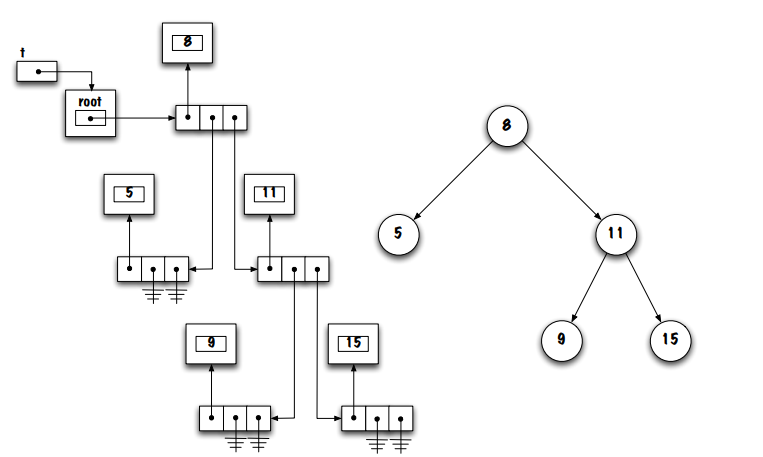
leaf node
a node where both left and right node references are null
how to tell if the tree is empty
if the root ref is null
boolean contains(E obj) (recursive implementation)
returns true if the value is in binary tree
“contains(obj, root)” calls the recursive method, which is a private method that can only be called from inside the class

recursive list processing main components
starter method → calls the recursive method
recursive method → almost always has one more parameter than the starter method
boolean contains(Node<E> current, E obj) (recursive implementation)
the base cases:
if the elem is not in the binary tree (current == null)
if the elem is found (obj.compareTo(current.value) == 0)
the recursive cases
if the value of obj is less than the current node (recursive call current.left)
if the value of obj is greater than the current node (recursive call current.right)
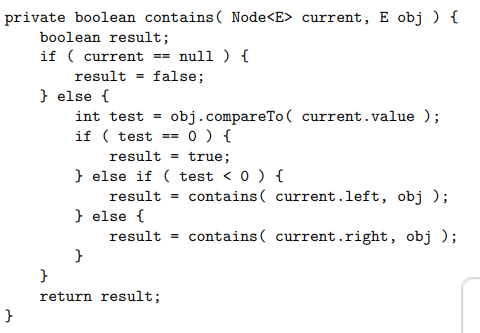
boolean contains(E obj) (non-recursive implementation)
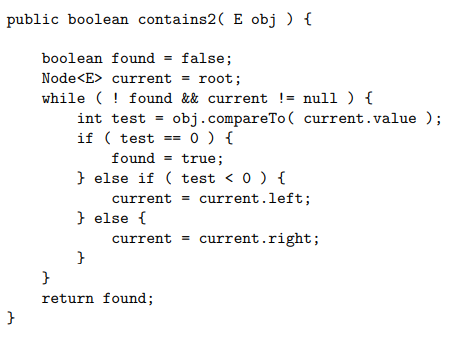
three different ways to traverse a binary tree
pre-order: current, left, right
in-order: left, current, right
post-order: left, right, current
starter methods for tree traversal
visit method is for printing the value of the node
the order methods all call recursive methods that have the same name
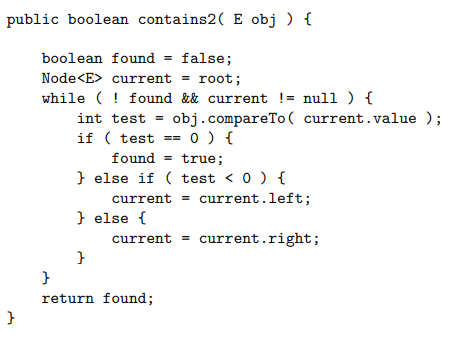
binary tree traversal: pre-order recursive method
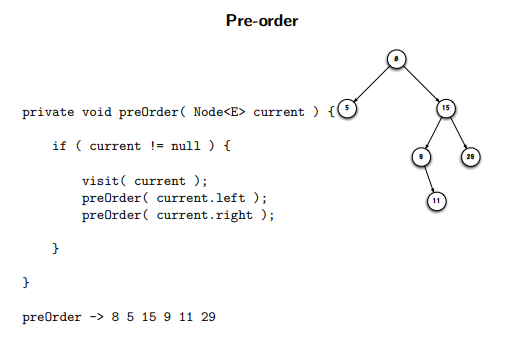
binary tree traversal: in-order recursive method
remember that IN-ORDER prints the elems in the order of least to greatest (moving from left to right)
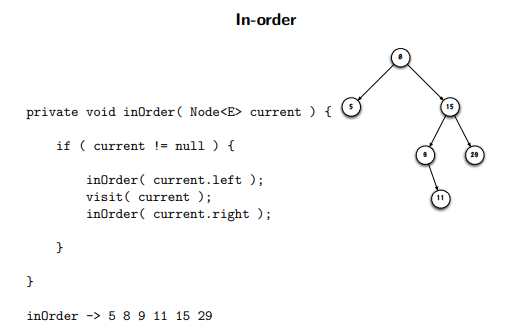
binary tree traversal: post-order recursive method
go to the left-most node
then go to the right most-node
then go to root
and repeat for subtrees
check that you have accounted for EVERY NODE
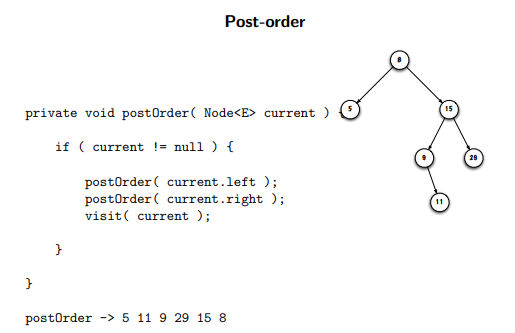
full binary tree
a full binary tree is when all nodes have exactly TWO CHILDREN except for the leaves
meaning no nodes have just one child
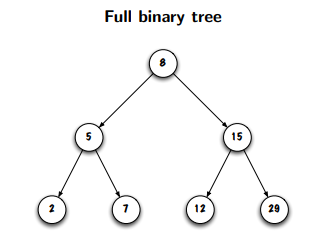
a balanced binary tree
a binary tree of depth d is BALANCED if all the nodes at a depth <= d - 2 have exactly two children (not zero or one)
the tree in the image is BALANCED bc the depth of the tree is 3, so every depth <= 1 has exactly 2 children
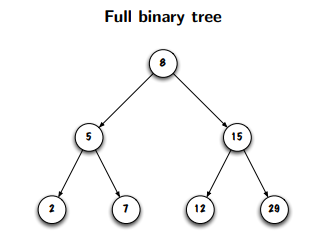
a balanced binary tree of depth d has
2^d to ((2^(d+1)) - 1) nodes
→ the size = 2^d to ((2^(d+1)) - 1)
the DEPTH of a balanced binary tree of size n (number of nodes in tree)
log2(n)
the relationship b/w efficiency and whether or not the tree is balanced for the contains method
a balanced tree would have better efficiency since the contains method eliminates a whole subtree with each comparison (divides the remaining nodes to traverse by 2, hence the efficiency being log2(n)
methods that work better with recursion
methods that follow a single path on the tree (from the root to some node) can easily be implemented w/o recursion
methods that must visit more than one-subtree simultaneously are better w recursion (like toString which prints the tree out like an array)
boolean add(E obj): special case
method adds an elem to the tree
very similar to the contains method with the comparisons
special case is if the tree is empty so the elem you add becomes the root → root = new Node<E>(obj)

boolean add(E obj): general case
like the contains method, add follows a single path from the root to some node, so it does not need a recursive implementation
always replaces null by a new value
the structure of the tree is unchanged
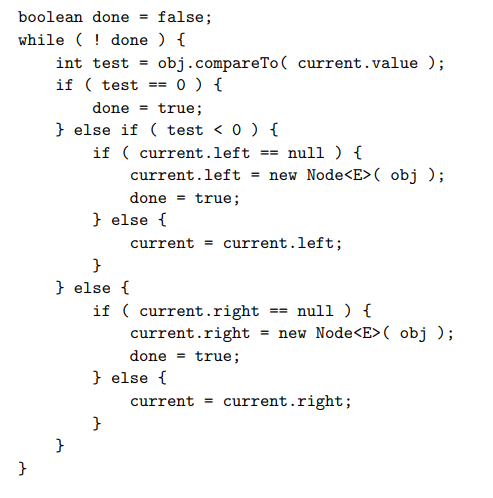
Node<E> remove(E obj): 4 main cases
node (whose value == obj) has no sub-trees → remove the sub-tree
node has a left sub-tree ONLY → replace the node by that sub-tree
node has a right sub-tree ONLY → replace the node by that sub-tree
the node has two sub-trees → either replace with the value that immediately precedes (the value less than) or replace with the value that immediately follows (the value greater than)
consider that each case can have the value be the root, in which the replacement node must be referred to as the root
Node<E> remove(E obj): case for removing the root
removeTopMost(Node<E> current) is where the bulk of the code is
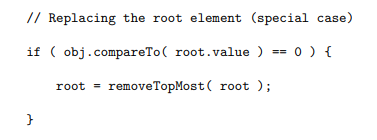
Node<E> remove(E obj): pre-conditions
the obj must not be null
the tree must not be empty
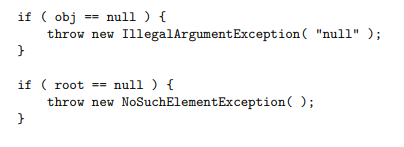
Node<E> remove(E obj): case for if the obj is not found at root
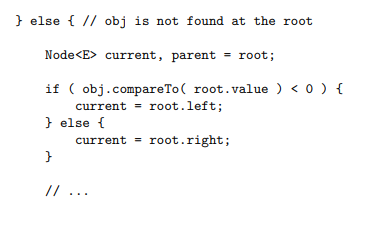
Node<E> remove(E obj): general case for finding the node to remove
first if-statement is for if the obj-to-be-removed is found
second if-statement is for if you still need to traverse
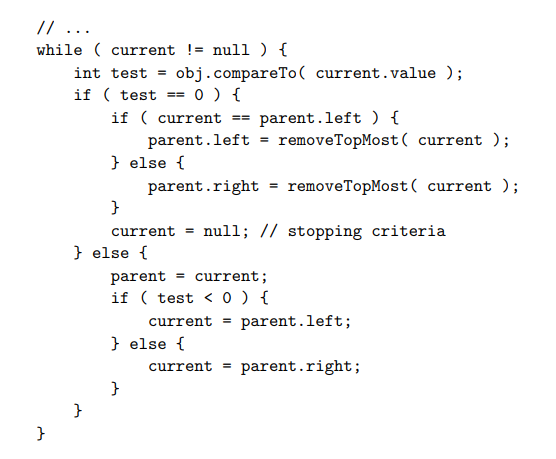
Node<E> removeTopMost(Node<E> current)
first checks if “current” only has one subtree
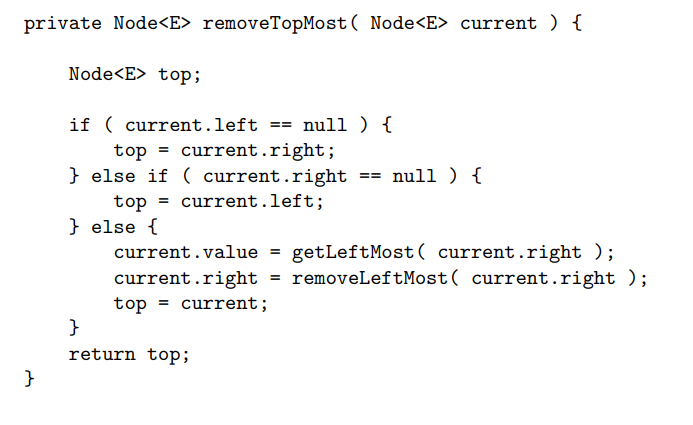
E getLeftMost(Node<E> current)
→ recursively finds the left-most node
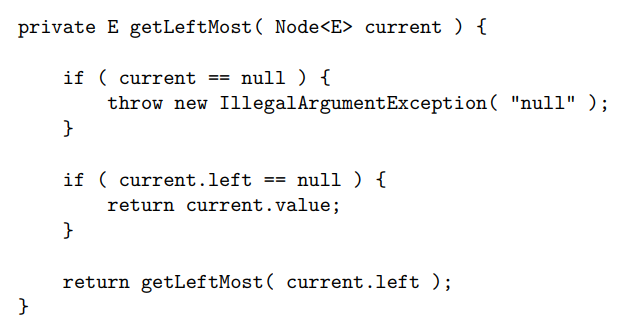
Node<E> removeLeftMost(Node<E> current)
→ recursively finds and removes the left-most node
“parent” always points to the node that was the previous node that “current” pointed to
replaces the left-most node with its right neighbour
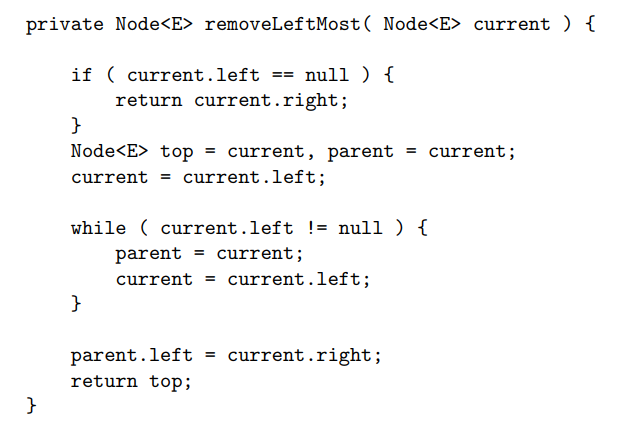
PreOrderIterator
this code does not include the next() and hasNext() methods
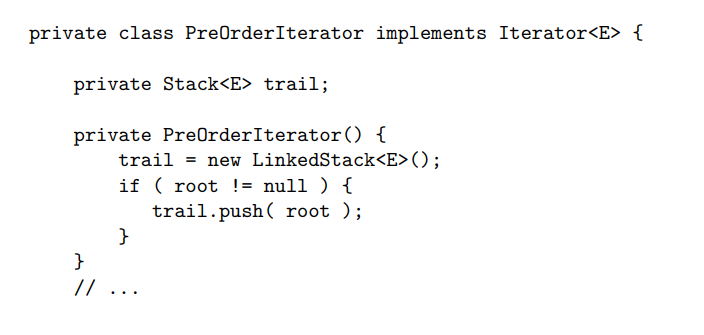
PreOrderIterator nested class: boolean hasNext()

PreOrderIterator nested class: E next()
